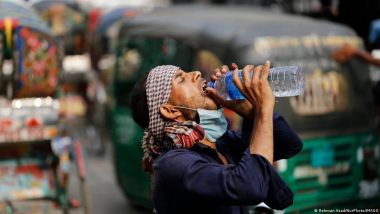Under current climate policies, billions will face deadly heat, with the elderly, children, women and people with disabilities hit worst. A global network of heat officers are tackling the problem in their own cities.Dangerous heat in European countries in 2022 disproportionately affected people with disabilities, who faced risk of physical, social and mental health distress and even death due to temperature extremes, according to a report by leading watchdog Human Rights Watch.
People with disabilities are more likely to have health conditions or use medication that can affect the body's ability to respond to heat, with HRW calling for more support.
Also Read | India News | 12-year-old Girl Raped in Punjab’s Hoshiarpur.
The report comes not long after other recent research found that 2 billion people will live in hazardous heat conditions by the end of the century if climate policies continue on their current trajectory.That represents 23% of the projected global population.
If the climate warms more drastically — a potential scenario under current policies — about 3.3 billion people could face extreme temperatures by the end of the century, according to a study published in the Nature Sustainability journal in May.
The study, led by scientists at the UK's University of Exeter and Nanjing University in China, found that 60 million people are already exposed to dangerous heat levels, characterized by an average temperature of 29 degrees Celsius (84.2 degrees Fahrenheit) or higher.
How do hot temperatures harm human health?
Extreme heat can result in a range of illnesses and death, according to the World Health Organization (WHO). These include heatstroke and hyperthermia. Temperature extremes also worsen chronic conditions and have indirect effects on disease transmission, air quality and critical infrastructure.
The elderly, infants and children, pregnant women, outdoor and manual workers, athletes and the poor are particularly vulnerable to higher temperatures.
Limiting warming to the lower Paris accord target of 1.5 degrees Celsius above pre-industrial levels would still expose 400 million people to dangerous heat levels by the end of the century, the study found.
People living in India, Sudan and Niger will all be heavily affected by even 1.5 degrees warming, but 2.7 degrees will have enormous effects on countries like the Philippines, Pakistan and Nigeria.
Calculating the human cost of climate change
Researchers said their study breaks the trend of modeling climate impacts in economic rather than human terms.
"It invariably distorts value away from human lives and towards centers of wealth," Ashish Ghadiali, a climate activist and co-author of the paper, told DW, adding that modeling focused on economics "places more value on a life in New York State than in Bangladesh."
Most other models also prioritize current populations over future ones, with inequality in global warming being "both globally distributed, but also intergenerational," said Ghadiali.
"It fundamentally values my life more than my children's lives and certainly more than my grandchildren's lives," he said.
Looking at individual country impacts on dangerous heat levels, researchers found that current emissions from 1.2 average US citizens condemn a future human to live in extreme heat. Despite having disproportionate emissions, the US population faces a much lower threat from dangerous temperatures.
How can people be protected from extreme heat?
Previous studies have shown cities are particularly vulnerable to such dangerous temperature rises, due to the "heat island effect." Buildings, roads and infrastructure absorb and radiate the sun's heat more than natural environments like forests and water bodies, raising urban temperatures by as much 15 degrees Celsius in some cases, compared to rural areas.
Cities around the world are introducing the new role of chief heat officer to deal with inevitable temperature increases. One of those is Cristina Huidobro, who took up the post for Chile's capital Santiago in March 2022.
"Many cities in the world face extreme heat, but the solutions and the way you approach it are very, very local," Huidobro told DW.
Still, Huidobro said, they all broadly follow a three pronged strategy — preparedness, awareness and adaptation.
Preparedness can include categorizing heat waves in the same way as other natural disasters, or setting up an alert threshold to trigger a certain city response.
Huidobro said raising awareness of the dangers of heat are an integral part of the role.
"Taking care of yourself in an extreme heat event is really simple — drink water, seek shade and rest," she said. "Nobody has to die from extreme heat."
The third prong is adapting the city to the new reality of high temperatures, largely by creating more green spaces in the city.
Santiago has just launched an urban reforestation project to plant 30,000 trees across the city and develop strategies that treat the trees as part of the urban infrastructure.
"Trees, trees, trees, trees everywhere. It's bringing more green into the city," Huidobro said.
But planting trees isn't as easy as people think.
"We're putting trees in really dense streets, like in the main avenues of the city, where you have a lot of cement. You need to dig a hole and really do some civil works."
It's also not an instant solution to urban heat as trees need time to grow.
"The whole idea is to try to plant the shade that we're going to have in the next 20 or 30 years," said Huidobro.
The US cities fighting extreme heat
The United States — where previous studies have found 12,000 people die prematurely from heat each year — has appointed three chief heat officers so far, in Phoenix, Miami and Los Angeles.
The Californian city of Los Angeles, which is ranked as the most susceptible to natural disasters including heat waves, recently launched a campaign to build more "resilience hubs" with shade and cooling powered by renewables in high-risk communities. It already has a network of cooling centers mainly in libraries, where people can go to beat the heat.
They are also working on an early warning system for heat waves.
Phoenix, a city in the middle of the Sonoran Desert, is working on a number of adaptations, including building cooling pavements with a special sealant that reflects the sun. The sealant makes paths several degrees cooler to the touch and keeps the night air cooler.
The city of Miami in Florida is planning major urban tree-planting campaigns, and has also spent millions of dollars on air-conditioning units for public housing residents while providing financial assistance to help cover the energy bills of low-income households.
But Santiago's Huidobro said air-conditioning is generally a last resort for adaptation because of its climate impacts.
Santiago wants to plant 33 "pocket forests" that would be used as climate shelters, especially near schools and health facilities. These are an alternative to the air-conditioned cooling centers being developed in the US and Europe.
"During a heat wave people can go inside these nature-based cooling centers and get their shade, and rest and drink water," said Huidobro.
Edited by: Jennifer Collins
This article was updated on 26 June, 2023 with new research published by Human Rights Watch.
(The above story first appeared on LatestLY on Jun 26, 2023 06:00 PM IST. For more news and updates on politics, world, sports, entertainment and lifestyle, log on to our website latestly.com).













 Quickly
Quickly



















